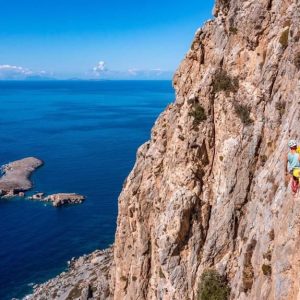Kalymnos – an island where sponges have been replaced by chalk
Switch to the Slovak version
You dream a climbing dream … you’re soaring and you can see the emerald-green sea from above. Somewhere below you, you can feel how the depth of the air sink into the depths of the body of water. Small islands patchily peek out from the magical depths. Each has a different, unique shape. With their rocky reliefs, they awaken your climbing imagination.
Suddenly your eyes fall on one of them and you can no longer take your eyes off it. You descent down and down… With each vertical meter, you can better distinguish the image you have in front of your eyes. Most of the island is covered with rocks sloping to the shores of the sea. This gently embraces it and creates picturesque bays around its perimeter. The rocks benevolently give way to green valleys in only two places. You can smell citrus and olives in them.
Then you will be interrupted by a loud command from the flight attendant: „We are landing. Fasten your seat belts.“ You awaken. You are on a plane that lands smoothly on the island of Kos in a few moments. Just a short distance from the „Promised Land“. There is only a short transfer from the airport to the port of Mastichari, from where you can take the nearest ferry to a place that will speed up your heartbeat by one hundred percent.
Welcome to the magical Kalymnos!
For a while, I wondered if I would even start writing about Kalymnos. It seemed impossible to compress the versatile beauty and richness of the island, as I repeatedly experience it, into a few lines of written text. In addition, in the form that it would be beneficial for a potential reader – a climber.
The final impulse finally came a few days after returning from last year’s trip. It literally came from the depths of my climbing soul. It is as if, through a written memory, she wants to remotely connect with the parts of herself that she leaves on this beautiful island, with each subsequent stay. Because of this, my writing style will probably be marked by emotions.
However, I hope that you will still find valuable information in the following lines. They could be beneficial to those who have heard of Kalymnos but have not yet tasted its climbing and other riches with their senses.
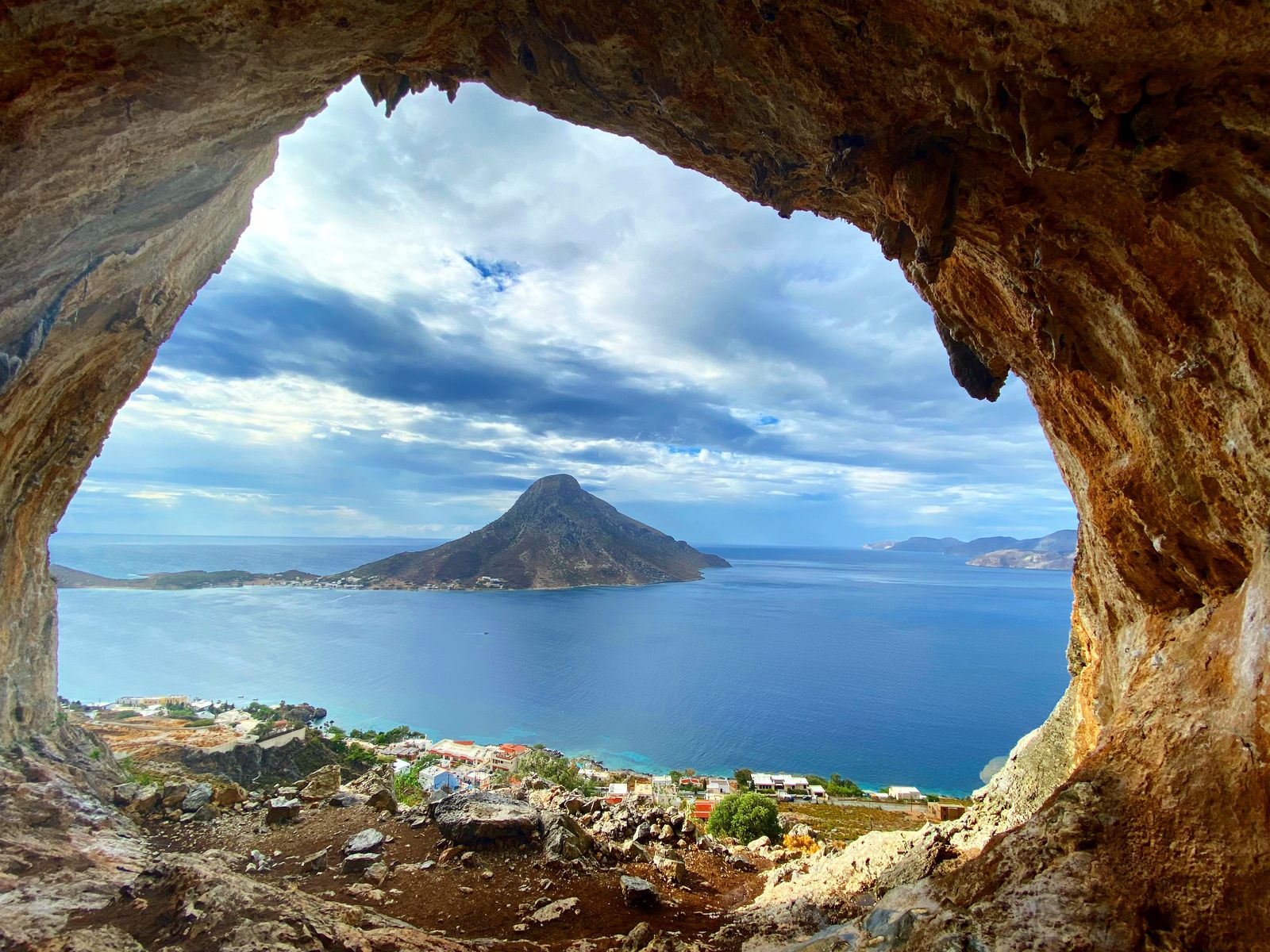
In the beginning of my climbing life, I was also what they call „Kalymnos naive“. I didn’t even know there was climbing at Kalymnos. After my more experienced climbing partner accidentally mentioned that such an island in the Aegean Sea exists, I began to google information. I think it was some older interview with Sasha DiGiulian who finally created a clear hologram of the perfect climbing paradise before my eyes. Enchanted by the island and the climbing on it, this top climber named Kalymnos as the climbing equivalent of the biblical Eden. And since I already knew that a ticket to paradise is not given only based on performance, I also bravely chose my first „onsites“ on there.
I returned to this memory on purpose. Some articles about this climbing destination may evoke the misconception that „rock athletes“ come here, looking for brutal overhangs. However, the truth is actually the opposite. At this island, the climber will find what he needs, from every part of the performance spectrum. You can climb here in a wide range of grades, from 3a to 9a. Almost half of the routes are graded up to 6b +. And if we count only grades 6a to 6b +, they represent one third of the total number of routes.
If a climber wants to try a beta from a „friend on the phone“, then it is probably best to call Adam Ondra, who redpointed this 9a at the age of sixteen in 2009.
There are currently more than seventy sectors (many with several subsectors) on Kalymnos and his „brother“ Telendos, with about 3,500 routes in total. So, climbers at any level truly have something to choose from. At the same time, there are ideal opportunities, whether for beginner climbers or those who want to undergo a rebirth from gym to rock climbers and, of course, for the mentioned hardmen. After all, only in grade 7b and higher, there are more than 700 routes available.
As far as I know, the most difficult route on Kalymnos is the 30-meters 9a (Los Revolucionarios). Potential applicant will find it in the Odyssey sector. If he has a problem climbing and he wants to try a beta from a „friend on the phone“, then it is probably best to call Adam Ondra, who redpointed this 9a at the age of sixteen in 2009.
For those looking for open projects in the highest numbers, there is the Troulos overhang, forming a beautiful orange cave. It is in the middle of the Arhi sector. Alex Megos has blown up a few routes, but there is still something to be found.
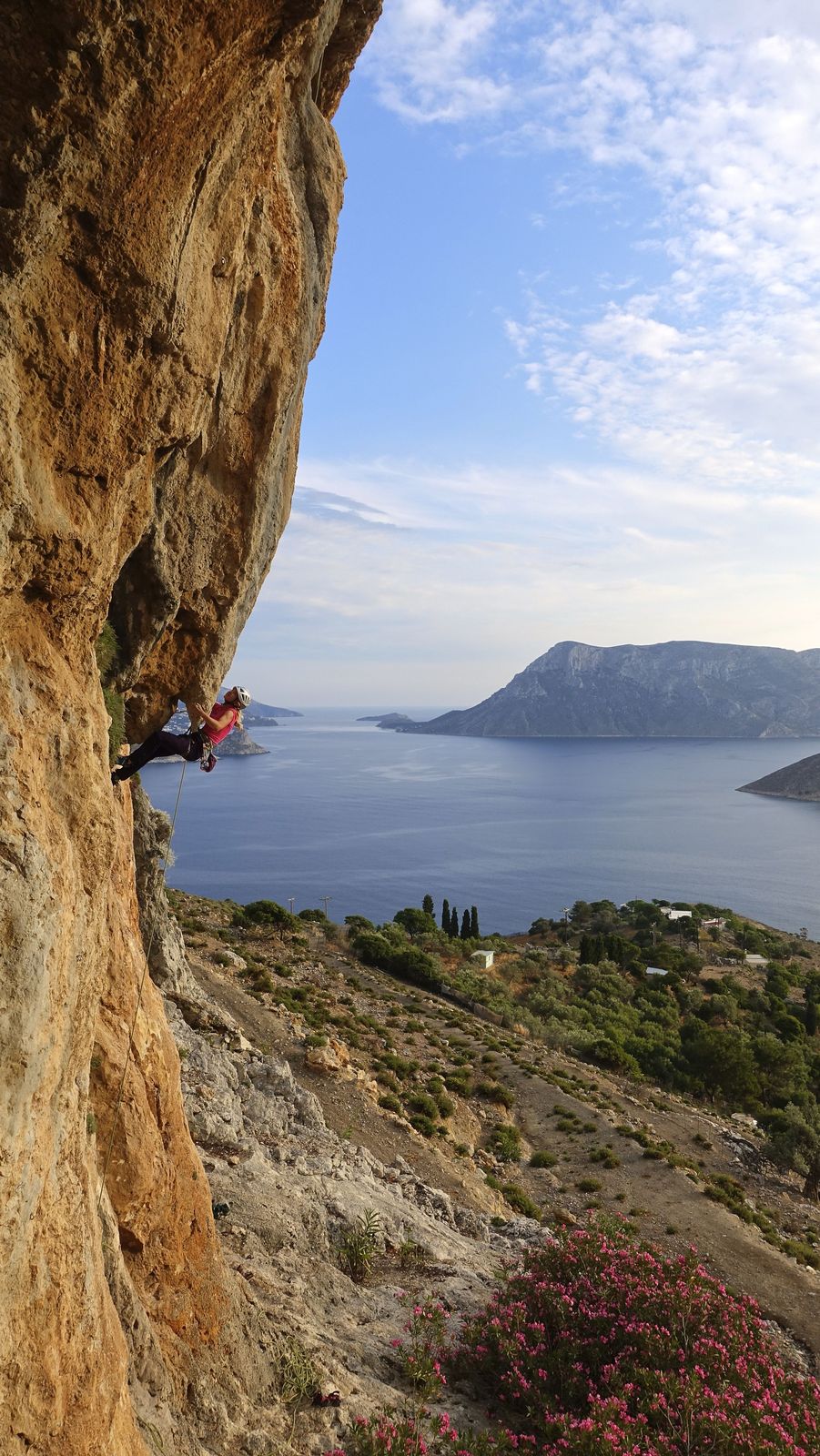
It started in the late 90s
Despite the respectable number of sectors and routes, climbing on Kalymnos has a relatively short history. Wondering who stood at the beginning? Who was the first to feel the island’s huge climbing potential? His name resonates with those who know the climbing history of the island to this day. It is Andrea Di Bari, who was one of the top Italian climbers in the 1980s and 1990s.
It was he who during his summer vacation in Kalymnos in 1996 noticed the excellent rock quality and potential of the island. A year later, he returned there with his friends, and the first 43 routes were made shortly. The local climbing came to the attention of the general climbing public after the articles in the magazines Alp and Rotpunkt were published in the spring of 1999. Since then, everything connected to climbing on this small piece of rocky land has had an exponential course. Nothing stopped the massive wave of new routes and climbing on this island.
Di Bari was right. Limestone on Kalymnos is of top quality. In some places it’s sharp, which is to be expected in coastal areas. The negatives of torn bellies of fingers are balanced by other qualities. You will not encounter a polished rock here very often. And climbing shoes, even on miniature jibs, hold somehow better than you are used to.
The character of the shapes of the rock surfaces is rich here. Gray plates, vertical to slightly overhanging white and orange walls, some almost without holds, others with pockets and jugs of various shapes, often in combination with smaller tufa features. And finally, the type of rock that many travel to and that allows to climb at photogenic angles. Extremely overhanging walls with blobs, tufas, stalactites, and various other shapes, for which I have a hard time finding an expression. You will often encounter a route in which you will experience a combination of all of the mentioned possibilities. In short, climbing on this island is nowhere near the danger of being monotonous.
At Kalymnos you will only encounter bolted sport routes. There are almost no boulders. Don’t even look for trad climbing opportunities here, though there are some very well bolted multi-pitches.
Multi-pitches of Telendos
However, if you are looking for real all-day multi-pitch entertainment, bounce back to nearby Telendos. There you can enjoy 8-11 pitch routes, from grade 6a. It is necessary to leave early in the morning, because the walls are oriented to the south and there is heat from noon. Every morning around seven o’clock the boat from the port in Myrties goes to Telendos, with climbers who have similar intentions.
In addition to the domination of various nations and pirate raids, Kalymnos has been regularly exposed to many natural disasters and earthquakes in the past. One of them (in 535) fundamentally changed the morphology of the island. A part of it separated and formed the small island of Telendos. Climbing gradually expanded there as well. In addition to the mentioned multi-pitches, there are several interesting sectors.
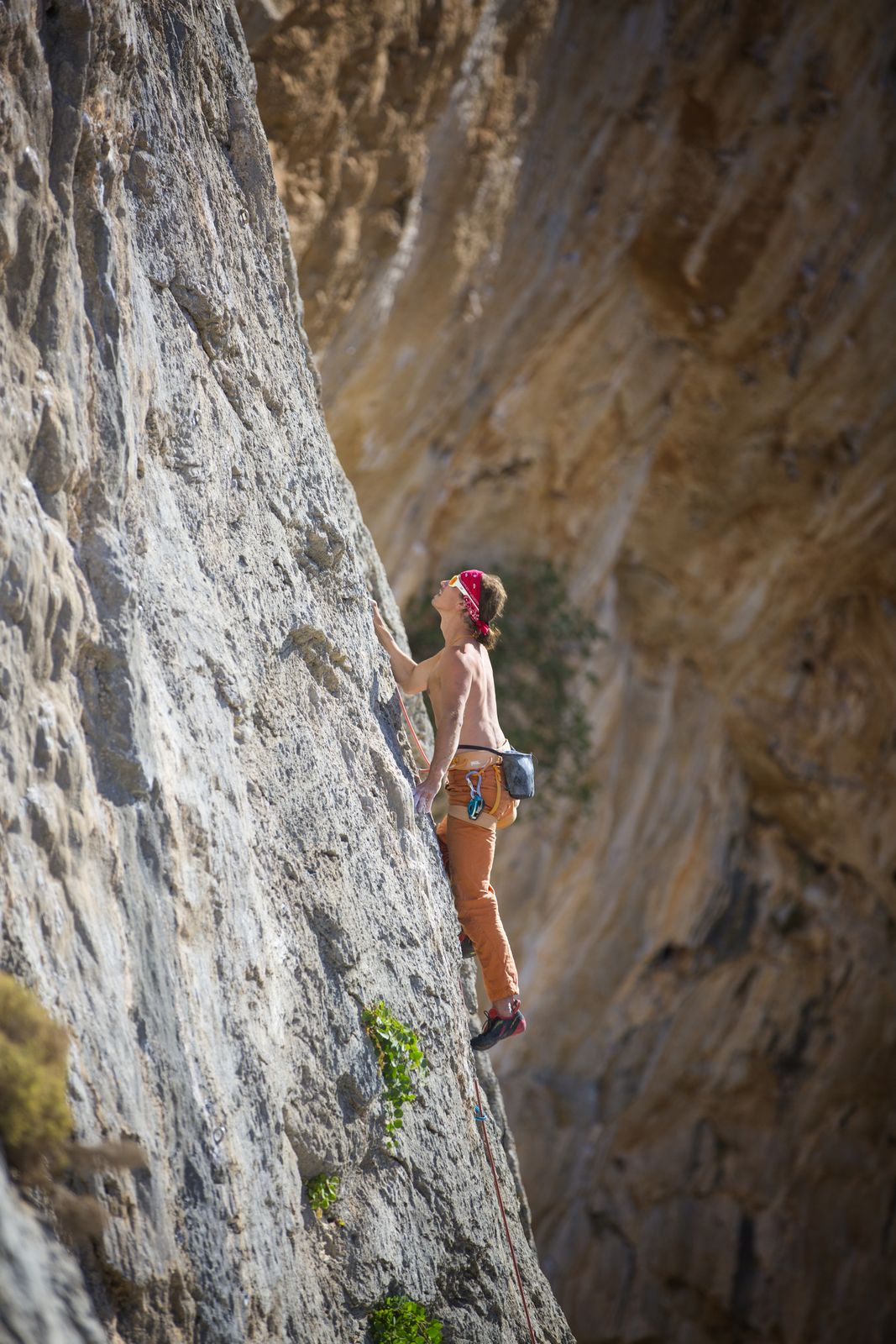
Boats to Telendos and back shuttle about every half hour. It takes about 10 minutes to arrive at the port, but you don’t have to end the ride there. If there are other climbers and they agree, the boat continues directly below the Irox sector. This will save you time for approach to more distant sectors. Otherwise, add an hour of walking time.
Long rope and many quickdraws
The length of routes on Kalymnos and Telendos often ranges from 35 to 40 meters. For this reason, taking a 60-meter rope to Kalymnos can be limiting when choosing routes in some sectors. With a regular coiling of your 80s, you may have hands like an orangutan at the end of a three-week stay, but if you can take a longer rope, do it. When belaying critically long routes, it is also good to remember the methodical rule about the knot at the end of the rope.
The need for the number of quickdraws also corresponds to the length of the routes. When trying to pack within the weight limit, try to throw something different out of the backpack, but consider 22 quickdraws as the optimal amount. We once witnessed how the local climbing guru and creator of many routes Simon Montmory helped himself by turning off the lower quickdraw and then turning it above. However, this technique may not be suitable for everyone, and he probably did it only as a fun number for his clients.
As is clear from the previous lines, the grades of the routes are according to the French scale in Kalymnos. You may come across the idea that the scale is „softer“ here. While it is true that it´s generally „climbers friendly“, do not be fooled by this and do not consider it as the rule. Just as you will experience the impression of an easier climb to a given grade, you will also experience the opposite surprises.
You can’t rely on the homogeneity of the scale either by sector or sometimes by author. The fact that the scale on Kalymnos „flies“ is mainly because routes are equipped by climbers from all over the world and it is certainly not easy to ensure a consistent gradation of so many routes.
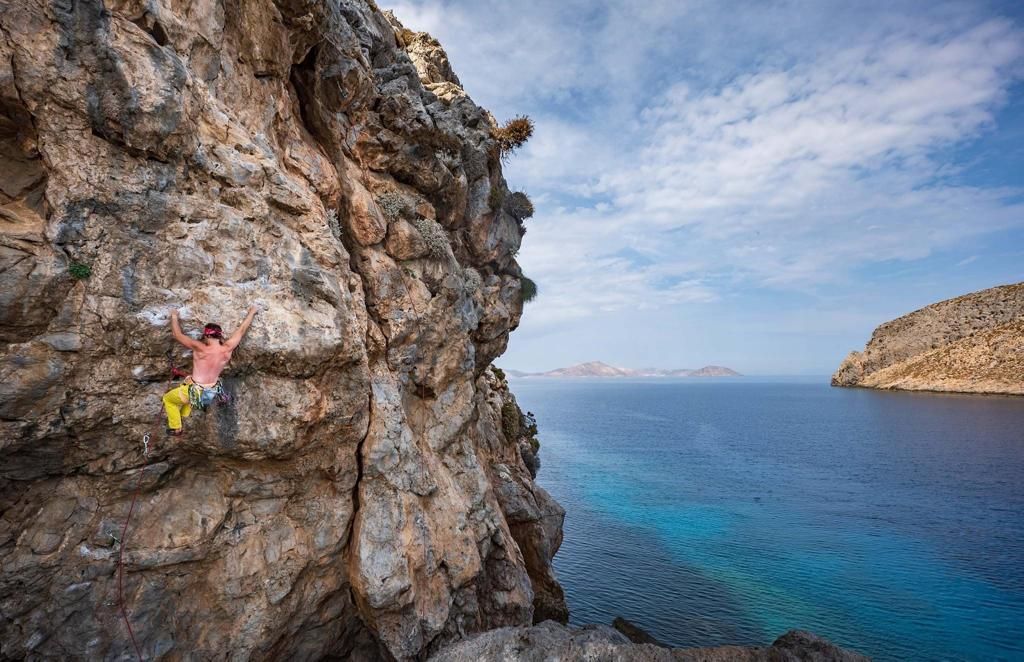
Various bolts
Routes are bolted in the sports standard. Here too, however, as in determining the difficulty, the individuality of the author is reflected. You may sometimes use the word „moral“ when climbing in some sectors.
Routes are equipped from about eighty percent of HCR expansion bolts, the rest glue- in bolts. You will most often find two opposite carabiners at the lower-off, but this is also not the rule. Sometimes you will be surprised by the circle. Two carabiners and some slings can be useful in addition to the already mentioned quickdraws on the harness.
The state of bolts is not the same everywhere. The humid coastal climate and the higher salinity of the air do their thing. Even though since the early period there has been an effort to do regular route maintenance and since 2008 several hundred routes have been rebolted, it is advised to look at the condition of the bolt into which the quickdraw is clipping.
Crowded autumn
The adverse impact of the Mediterranean climate on the materials used is probably its only negative aspect. There are many more positives. One of them is the possibility of year-round climbing. The top seasons are spring and autumn, but even in the remaining two seasons, Kalymnos is not completely without climbers. However, the ideal climbing season is still autumn, especially October. The days are practically without precipitation, exceptionally there is a storm. Air temperatures are around 22 degrees on average. And the sea temperature is still pleasant for swimming.
However, there is one catch, many know it and I have a feeling that their number is increasing every year. At this time there is a real peak of the climbing season. If you are traveling at the last minute, it is harder to find suitable accommodation and last year there was also a problem with renting a scooter. This is the most common means of transport on the island.
Popular sectors are bursting at the seams, and if you have specific routes in them, you often need to arm yourself with the necessary amount of patience. But even in this period, you can get on well with Kalymnos, you just have to combine different options and plan a little more. Flexibility in the choice of sectors and routes will return to you, in the form of unforgettable climbing experiences. Even in October, you can, in less popular sectors, climb with your climbing partner alone.
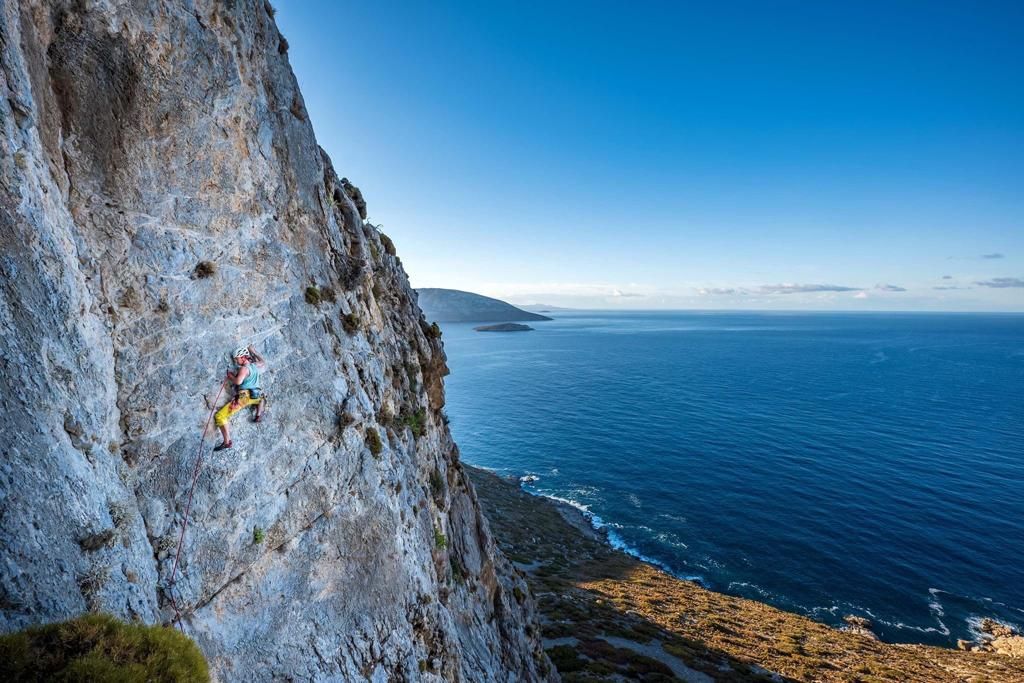
How about spring or winter? And actually summer too
The spring season is almost as good for climbing as autumn. The temperatures are similar, just a few rainy days may occur. But the rocks dry here quickly. However, the difference is in the sea temperature. It will make up for the fact that you will experience the island at a time when nature is most beautiful in bloom.
This is rare because there is little vegetation here. However, it is balanced by the richness of plant species. In addition to the most common ones, such as thyme, oregano and sage, hundreds of other flowers and plants grow here. You can climb here relatively well in the summer, if you follow the rule that you will climb in the shade. Believe that thanks to the refreshing breeze blowing from the sea, you will welcome long sleeves when belaying during summer mornings.
I wrote the above based on my personal experience. I haven’t tried only the winter climbing on Kalymnos. But I have no reason not to believe that in a period of clear, dry days, climbing in the southern sectors can be excellent. Accommodation and dining options are more modest in winter, but there is always a place to eat and rest. Transport is also more complicated, as most flights to Kos end with the summer schedule. The idea of those empty sectors in winter and the peace on the island is, however, very tempting.
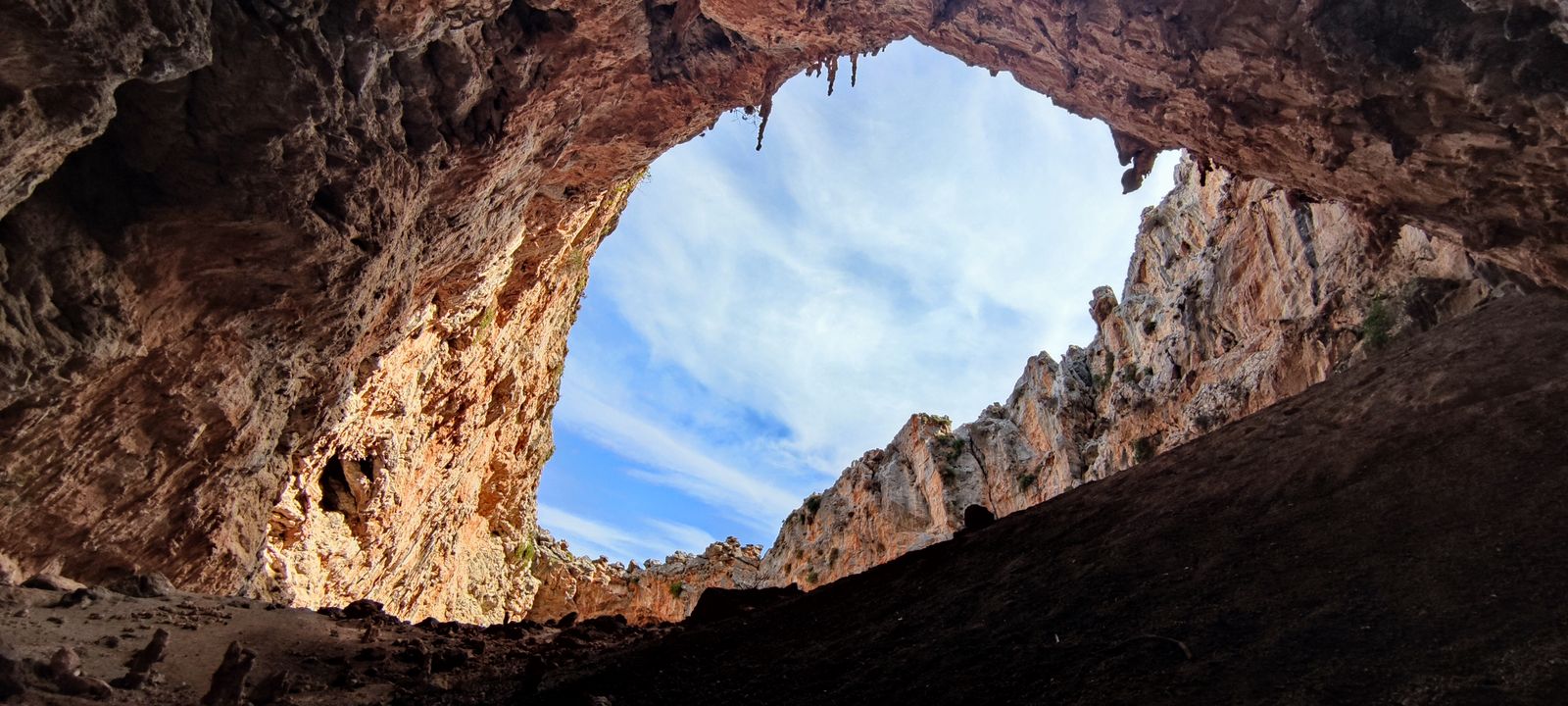
Study the guide in advance
Given the rich climbing potential, this may sound like a paradox, but traveling to Kalymnos without a more or less clear idea of what and where you want to climb would be a sinful waste of precious time. Investing in a climbing guidebook well in advance is more than appropriate. In addition to minimalizing the chaotic selection of sectors and routes, you will also contribute to a good cause. This is because part of the funds from the sale of guidebooks is used for route maintenance and rebolting.
The guidebook exists in both printed and App form. The latest, seventh edition, is from 2019. The authors are Aris Theodoropoulos and Katie Roussos. Aris currently honours Di Bari’s torch. He is an important person in climbing on the island. Among other things he is a climbing instructor, a mountain guide, a route creator and the already mentioned author of climbing guidebooks. He spends much of his life developing climbing, especially on Kalymnos, but also in other parts of Greece.
Even in the case of a climbing guidebook, the author managed to produce a piece of good work on Kalymnos. In the introduction you will find a clear „Crag Planner“, which describes all the basic characteristics of each sector, including their geographical orientation and climbing occupancy. This is, in addition to the nature of the sector and the difficulty of the routes, a very important figure. Especially in connection with the season in which you plan a climbing trip.
The guide also provides basic information about the island and lots of practical tips you may find during your stay. A natural part is the description of individual sectors and access to them. Brief descriptions of the routes are supplemented by their grade and information on the length. In addition, the „beauty“ of the route is stated, which is expressed by the number of stars (0-3 stars). Excellent routes are marked with a note symbol. Based on my own experience, I recommend not sticking to the three-star approach. You will be impoverished by the many wonderful routes that have gained the two stars, only under the influence of someone else’s subjective view.
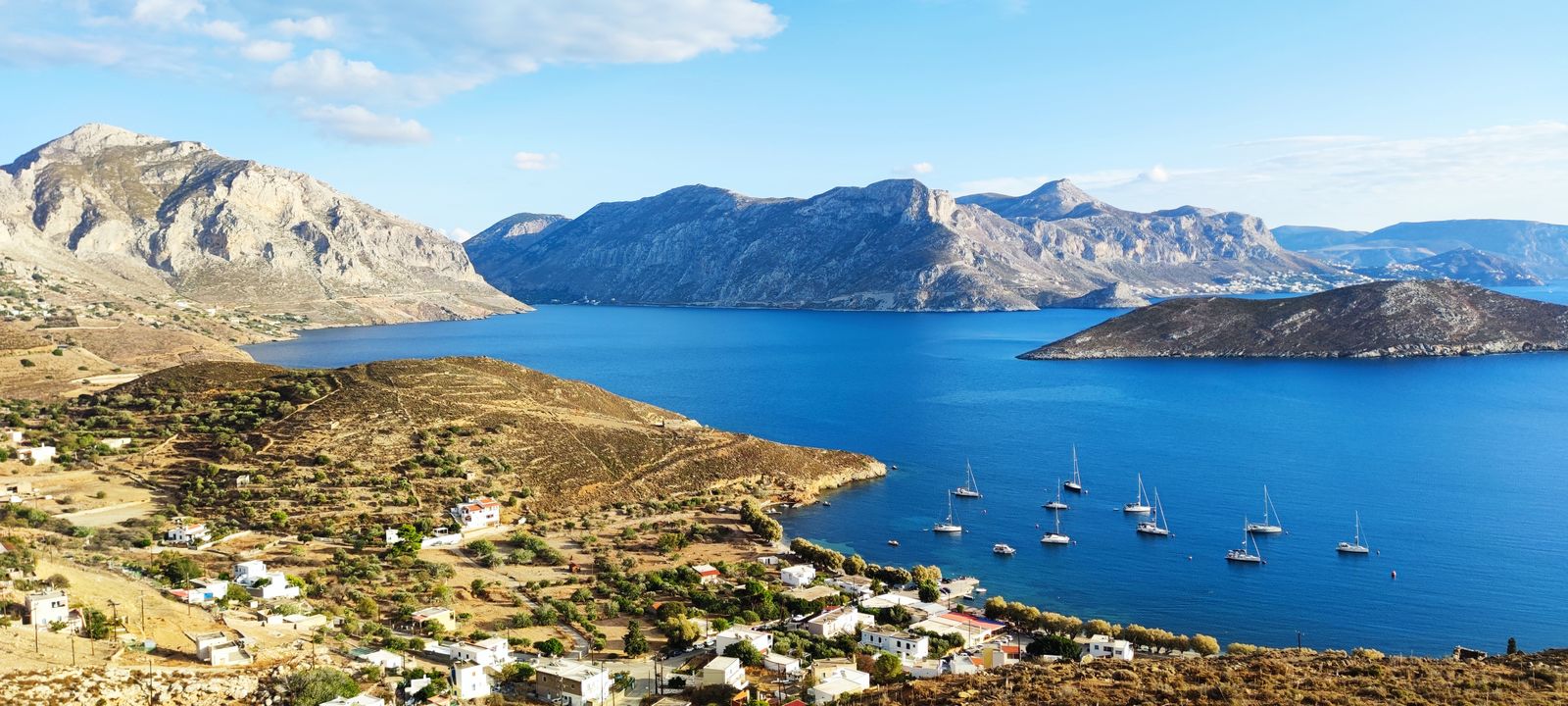
The ten most famous sectors
Trip planning, selection of sectors and routes is such an individual matter that it would not make sense to make any recommendations in this regard. I will give only the basic facts. The highest concentration of sectors is in the middle of the western part of the island, northeast of Masouri. The second area, where the sectors are practically adjacent to each other, is the area around Arginonta and northwest of it. Interesting sectors, although at a lower concentration, are also to be found in the north and inland.
The Grande Grotta sector is considered the „trademark“ of Kalymnos. Behind the name lies a unique cave, with a vertical range of 50 meters. The three-dimensional red limestone formation, with an incredibly high concentration of stalactites, has predestined this sector for extremely overhanging routes. Grande Grotta is one of the most visited sectors, as well as the three neighboring ones. To the right is the Panorama sector, to the left the Afternoon and the Spartacus sectors.
A little further north, there are two other sectors where you don’t have much private time with your climbing partner. These are the Odyssey and Summertime sectors. The first is oriented northwest, the second northeast. This makes them ideal adepts for warm, sunny days. Odyssey – one of the main and oldest sectors on the island – stretches along 400 meters of interconnected caves and walls. The rock is considered one of the best here, but to the Kalymnos standard it is sometimes slipped.
If you move on to Arginonta, the sectors whose walls are most densely adorned with climbers‘ coloured dots since early morning are Arhi and Arginonta. It is related both to their qualities and to their geographical orientation. Both are facing south, and they are in shadow only in the morning. The disadvantages of these sectors, in terms of climbing conditions during the main periods of the climbing season, are compensated for on colder, cloudy days and in winter. The ten most visited sectors are closed by Ghost Kitchen, near the village of Skalia and the Secret Garden in the north of the island.
The scope of this text does not allow for a more detailed description of the sectors, whether mentioned or not. Those, although not in the „top ten“, often do not lag behind in many respects. On the individual path of discovering the beauties of individual areas and climbing in them, the most attractive is the discovery itself. It is often associated with unforgettable experiences and moments that can be so unique as to create a lasting record in our world of remembrance. And I wish each of you to experience as many as possible.
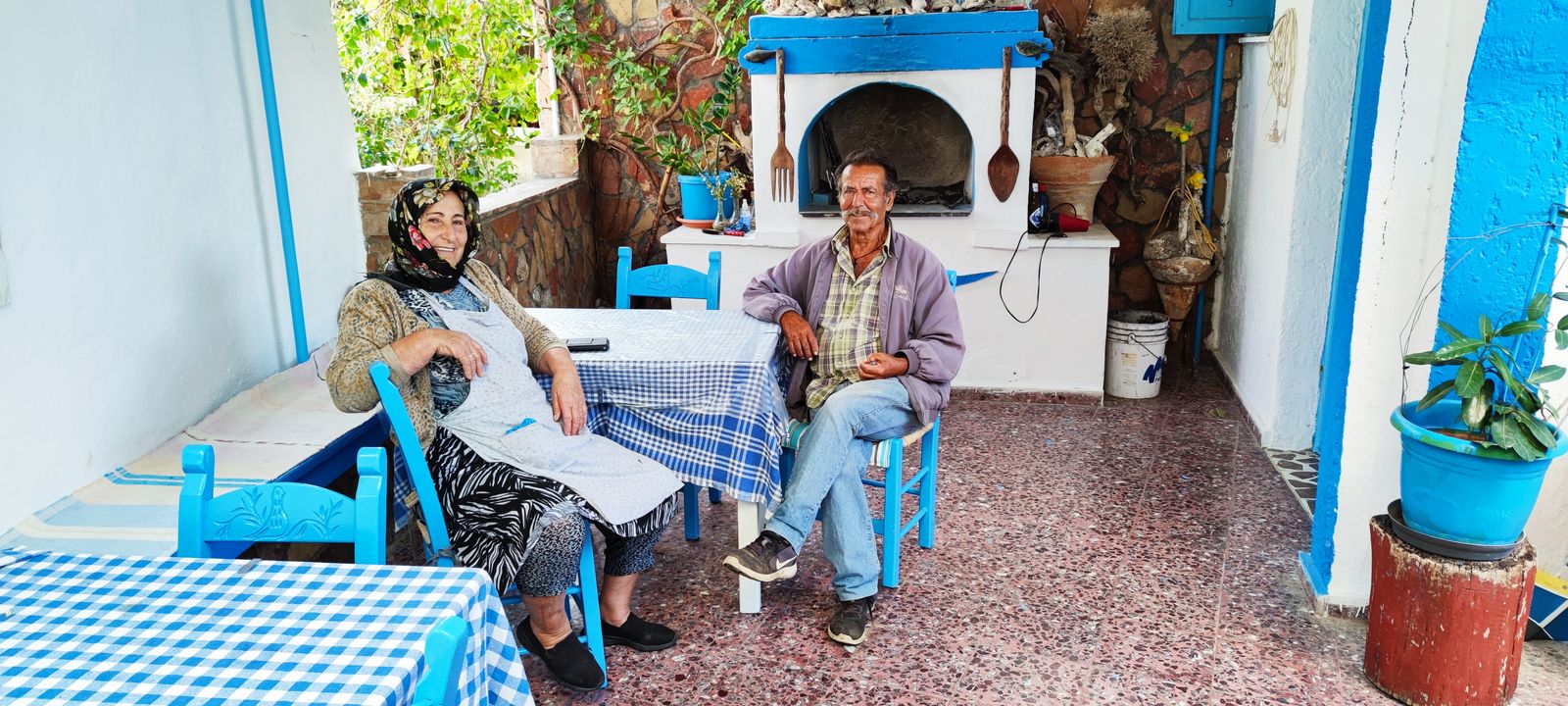
My written return to Kalymnos is coming to an end. I would like to continue with it, but the scope of the article does not allow me to do so. My fear has come true. In retrospect, I did not manage to compress the soul of the island and the climbing life on it into the text. At least not to the extent to which I am satisfied with the result.
Among other things, many beautiful places remain untapped, which I consider worth mentioning. Among them are places where you literally ascend through history as you cross the ruins of ancient temples. Picturesque white-blue chapels, still open, offering space for a moment to bend in humility. Lonely, wild beaches, where swimsuits are useless when swimming during a rest day.
I also have no space to mention the local people in more detail. They are friendly and mostly very authentic. But in time, you will know many of them by yourself. You will find out where Kostas has a climbing café. Where Lina, who is living on Kalymnos all her life, sells „miracle“ arnica oil and knows the answers I guess to all questions about the island. After climbing Telendos and having dinner at Rita Tavern, Miltiadis Zoidis, the owner of the restaurant, may tell you the story of his father, Yannis. And you will remember these words, even if you go to the sectors in Palionisos and at the last minute you avoid a collision with Nikolas, the unofficial guard of the bay.
I also owe you why the sponges are in the title of the article. It’s a long and interesting story. However, I hope that despite the imperfections of the text, some of you will find my lines useful. I wish you many nice moments and adventures during your personal discovery of Kalymnos. It’s really magical!
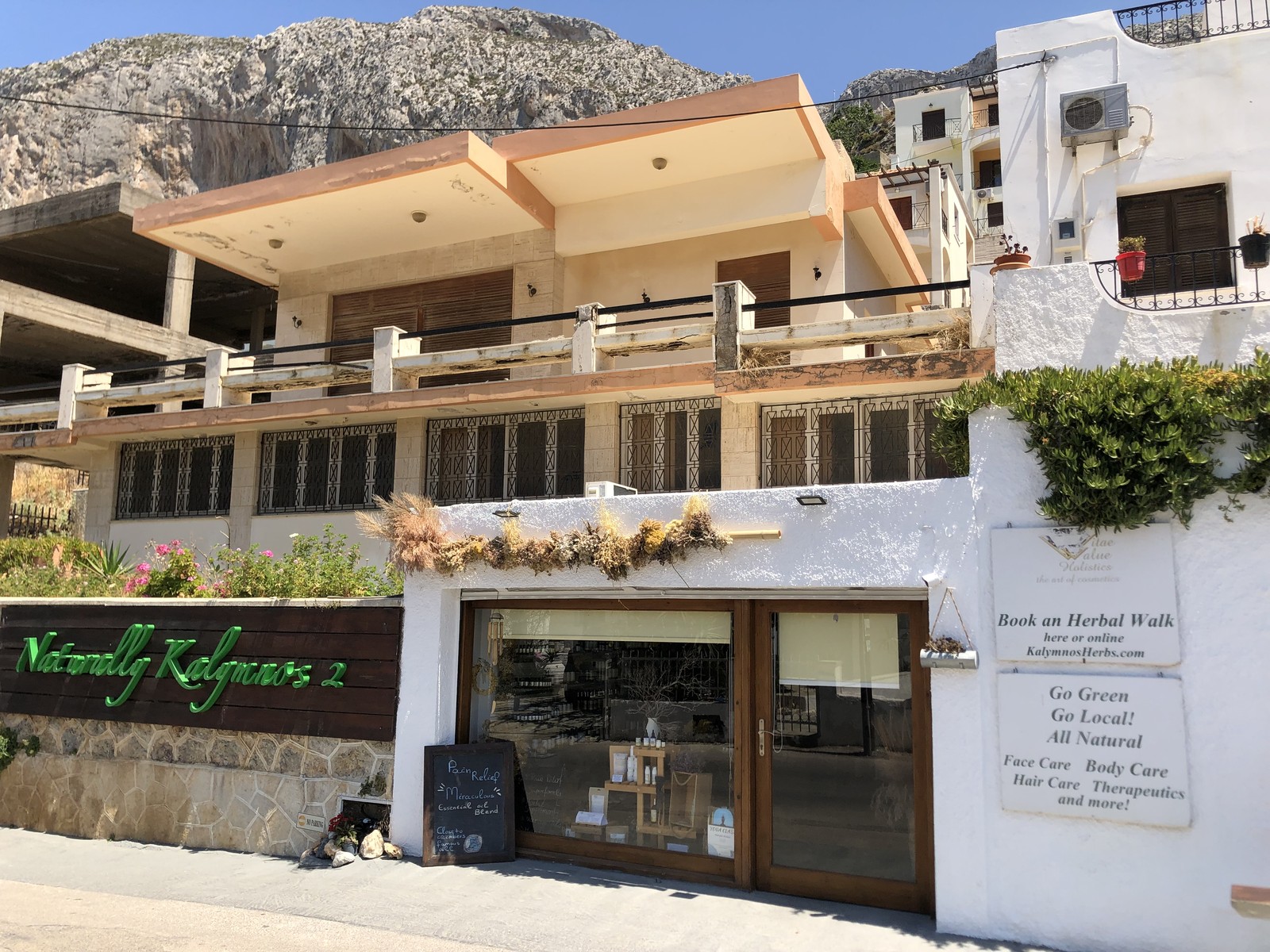
Photos by Martin Murár, Ladislav Boszorád, Rasťo Hatiar, Martin Krutek
[related_posts_by_tax format=“link“ title=“Author recommends“ posts_per_page=“6″]

